Heads up! We may use affiliate links in this post. You'll never pay more, but we might earn a small commission if you buy - thanks for supporting us! See our full disclosure here.
I adore how vibrant colours have this magical ability to uplift my spirits and infuse my days with a bit of excitement, but I can’t deny the allure of Japandi design either!
There’s just something captivating about the way Japandi effortlessly combines the best of both worlds—the serene simplicity of Japanese minimalism and the cosy warmth of Scandinavian design.
Japandi lighting options allow you to achieve the perfect balance of form and function too.
Japandi lighting fixtures are designed to create a harmonious and balanced look in any room.
Their understated elegance and neutral colour palettes allow them to blend effortlessly with a variety of interior styles, enhancing the overall aesthetic without overpowering it.
Whether it’s a sleek pendant light above the dining table, casting a soft glow over intimate dinner gatherings or a minimalist floor lamp in the corner of the living room, these no-frills lighting options are perfect for providing just enough illumination to create a warm and inviting atmosphere for those cosy evenings in.
That being said, we’re shedding some light on how you can brighten up your home with these charming lighting fixtures.
Understanding Japandi Design & The Characteristics

To kick things off, let’s explore what Japandi design is all about.
As Adrika, an in-house interior stylist at Castlery puts it, “Although worlds away from each other, the Scandinavian and Japanese designs encompass very similar belief systems…Japandi takes these principles and combines them to create a balanced, serene living space that is soothing and ordered.”

Key Characteristics Of Japandi Design
Here are the key characteristics of this style:
Minimalism and Simplicity: Japandi design emphasizes clean lines, uncluttered spaces, and a minimalist approach. This reflects the Japanese principle of “Ma,” which focuses on the use of negative space to create a sense of balance and tranquillity.
Natural Materials: The use of natural materials such as wood, bamboo, stone, rice paper and linen is fundamental to Japandi design. These materials bring warmth and a connection to nature into the home, enhancing the serene and organic feel of the space.
Neutral Colour Palette: Japandi interiors typically feature a neutral colour palette, including light to medium wood tones, grey, beige, and off-white. These colours create a calming and harmonious atmosphere, often accented with deeper natural hues like greens and black to add warmth and depth.
Functionality and Practicality: Both Japanese and Scandinavian designs prioritise functionality. In Japandi style, every piece of furniture and decor has a purpose, contributing to a clutter-free and efficient living space.
Connection to Nature: A strong connection to nature is a hallmark of Japandi design. This is achieved through the use of natural materials, the incorporation of plants and greenery, and large windows that allow for plenty of natural light.
Handcrafted Elements: There is a focus on craftsmanship and quality in Japandi design. Handmade items, such as ceramics and wooden furniture, are often featured, emphasizing durability and a personal touch that adds to the aesthetic and emotional value of the space.
Balanced and Ordered Spaces: Japandi design aims to create balanced and ordered spaces that promote tranquillity and well-being. This involves thoughtful arrangement of furniture and decor to ensure a seamless flow and a sense of openness.
Japanese vs Scandinavian Design
While Japanese and Scandinavian design share some similarities, especially in terms of minimalist design, they also have distinct differences that reflect their respective cultural influences and design philosophies too, here’s the difference:
Japanese design is characterised by clean lines, uncluttered spaces, and a focus on the beauty of simplicity.
It draws inspiration from Zen Buddhism and traditional Japanese aesthetics, which prioritise harmony, balance, and the appreciation of natural materials.
In Japanese interiors, you’ll often find elements like tatami mats, shoji screens, and sliding doors, as well as a restrained colour palette dominated by neutral tones.
Scandinavian Design
On the other hand, Scandinavian design is influenced by Hygge (pronounced hoo-gah), a Danish concept that embodies cosiness, comfort, and well-being.
Scandinavian design often incorporates elements of hygge, such as soft textiles, candles, and comfortable seating arrangements, to create inviting and relaxing spaces
Scandinavian design also values craftsmanship and quality, with an emphasis on well-made furniture and timeless design.
Exploring Japandi Lighting Styles
Ok! Now we’ve covered all that, let’s get to the lights!
Japandi Floor Lamps
Floor lamps are ideal for creating cosy, well-lit spaces without the need for overhead lighting.
Creating Cosy Spaces:
Reading Nooks: Floor lamps are ideal for creating inviting reading areas. Choose lamps with adjustable arms or heads to direct light precisely where you need it.
Corners: Brighten up dark corners with a floor lamp that adds both light and style. A tall, slender design can make a space feel larger and more open.

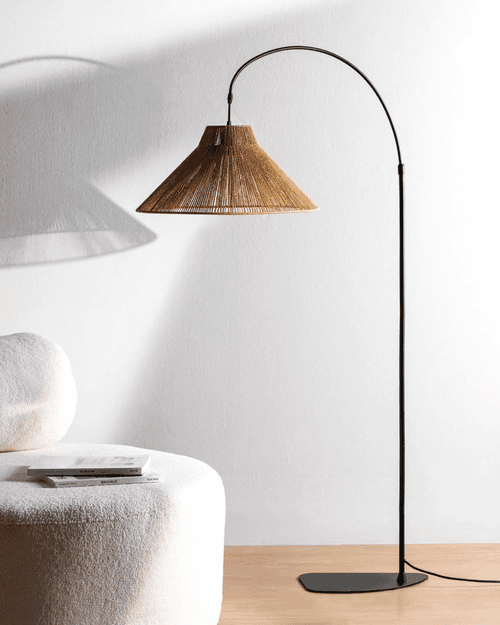
Japandi Pendant Lights
Pendant lights are a versatile option that can be used to create a focal point in any room.
Versatility and Aesthetic Appeal:
Dining Areas: Pendant lights are perfect for hanging over dining tables, creating a focal point that also provides ample light. Opt for fixtures made from natural materials like wood, bamboo, or rice paper to enhance the Japandi aesthetic.
Living Rooms: Use pendant lights to highlight specific areas, such as above coffee tables or in reading corners. Look for designs with simple, clean lines that complement the minimalist nature of Japandi style.
Entryways: A well-chosen pendant light can set the tone for your entire home. Choose a fixture that blends seamlessly with the natural elements of your entryway decor.
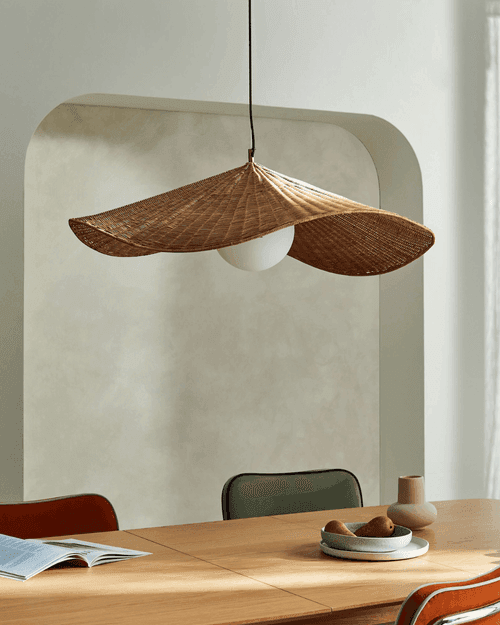
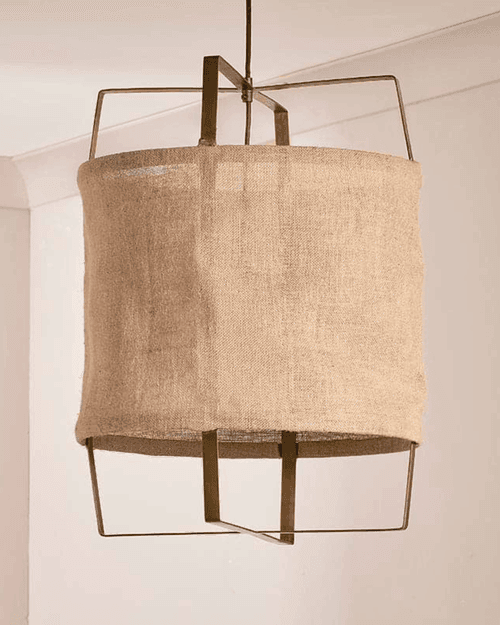
Japandi Table Lamps
Table lamps provide essential task lighting and can be used to enhance the ambience of various spaces. They are perfect for adding focused light where it’s needed most.
Task Lighting Essentials:
Bedside Tables: Table lamps are crucial for bedside lighting, providing soft light for reading or winding down. Look for lamps with dimmable features to adjust the light intensity as needed.
Desks: In a home office or study area, a table lamp with focused light is essential for productivity. Choose a design that complements your workspace.
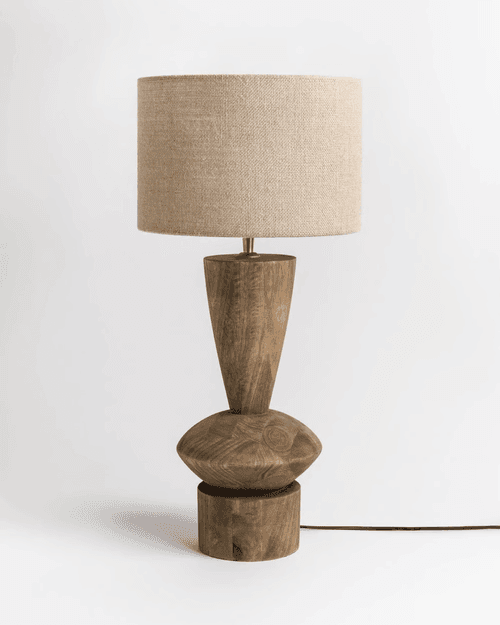
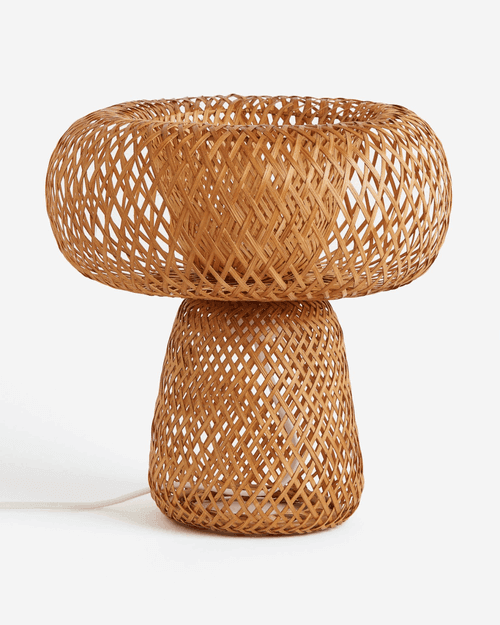
Japandi Paper Lanterns
Japandi paper lanterns are quintessential elements that embody the essence of Japandi style.
Made from natural materials such as rice paper, known as “washi” in Japanese, these lanterns provide soft, diffused light that creates a serene and tranquil atmosphere.
Classic Elegance and Soft Light:
Living Rooms: Paper lanterns can serve as both a decorative and functional element, providing a warm and inviting glow. Place them in corners or near seating areas to enhance the ambience.
Bedrooms: Use paper lanterns as bedside lights for a gentle, calming illumination that promotes relaxation and rest.
Outdoor Spaces: Enhance your outdoor areas with weather-resistant paper lanterns that bring a touch of Japandi charm to patios and gardens.


Japandi Wall Sconces
Wall sconces are an excellent choice for illuminating hallways, accentuating architectural features, and creating an inviting atmosphere without taking up any floor space.
Subtle Ambient Lighting:
Hallways: Select sconces that provide soft, ambient light to create a welcoming atmosphere.
Living Spaces: Use wall sconces to accentuate architectural features or artwork. The right sconce can add depth and interest to your decor.


Quick Recap & Tips
Ready to illuminate your space with Japandi lighting charm? Here are a few tips to get you started.
Aim for balance by combining natural and artificial light to create a well-lit and inviting ambience.
Embrace simplicity by opting for clean lines and minimalist designs in your lighting fixtures.
Incorporate natural materials like wood, bamboo, or paper to evoke the essence of Japandi design.
And finally, don’t forget to layer your lighting – combining ambient, task, and accent lighting can enhance both the functionality and aesthetic appeal of your space.
Save on Pinterest for later?


